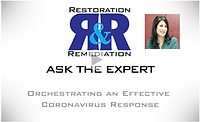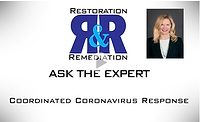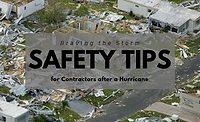When Hurricane Katrina struck in 2005, restoration and remediation companies from around the country responded to help with recovery. It’s estimated the deadly hurricane killed at least 1,833 people and did more than $108 billion in property damage, making it the costliest storm on record in the U.S. Just one year earlier, Duraclean launched its “After the Disaster” team. CEO Vince Caffarello gave Restoration& Remediation an inside look at what the team is all about.
What prompted the formation of the “After the Disaster” team?
Vince: During a convention in 2004, a franchisee spoke with someone from the local area – who was hit by a hurricane a few weeks later. That franchisee got a call to help dry several properties. It was a filling request. We mobilized franchises to satisfy the need and it was like, ‘jeez this works well,’ and the opportunities continued with more hurricanes that year. I’d like to say there was a lot of advanced planning, but it was really just to satisfy an opportunity and that put us in the large loss category.
What is done to make response seamless?
Vince: It comes down to people. To be a good restoration company, you have to have good people and I think at Duraclean, the fact that corporate is involved with many of the large losses, I think that it allows us to monitor the people that are on the jobs and how the jobs are done. There are many restoration companies across the country. Good people are what make the difference between one restoration company and another.
What does the cleanup process look like?
Vince: It’s site management. With each loss, you have to ask: what do you need, what kind of drying equipment are you going to have on site, what kind of power distribution is going to be needed, what is the loss going to need to get the place dried out, where are technicians going to stay, etc. You have to scope it out; you create some kind of preliminary number to get it done. You have to have that agreed upon by whoever is going to pay the bill. The administration of the loss is ongoing from the time you pull up to the time you pull away, documenting the loss from before, during and the after of the overall remediation of what you’re doing.
What are some of the team’s major response calls to date?
Vince: Every disaster is different. Certainly, Katrina was a very wide opportunity from Florida to New Orleans, how- ever even the fires in the Denver/ Colorado Springs area were another, and then those hurricanes that came north in New Jersey and New York. So they were all different in nature. I think when these disasters happen, there aren’t enough of us in the industry. Rarely do you have enough equipment and people to handle the opportunities so they last weeks and weeks as you continually work to clean up. You can read about the disaster when it happens, but no one writes about the tremendous cleanup later. So many different companies have their equipment and personnel assets dedicated to cleaning it up.
What's the most amazing story you've heard from a franchise?
Vince: After Hurricane Katrina hit, Proctor & Gamble couldn't produce coffee because of the damage. I can't imagine the millions of dollars spent on restoration marketing by Duraclean over the years, then this one job got us recognized by President Bush. He was arm-in-arm with the technicians. My gosh, this was a once-in-a-lifetime opportunity and it certainly bore a lot of fruit for Duraclean franchises. The Secret Service stepped aside, and the president just walked among the workers.
- 46% of water-logged homes had visible mold growth
-
Out of 112 homes in a "sample" area investigated by the CDC:
- 21 had flood levels higher than 6 feet
- 76 had roof damage with water leakage
- 51 had visible mold growth
- 19 had heavy mold coverage (more than 50% of the walls in the most-affected room)
- 28 hours (on average) of cleaning was done in most homes
-
The CDC interviewed 76 remediation workers. Here's what they found:
- 95% thought mold causes illness
- 85% wore respirators
- 49% did not fit-test the respirators
- 35% did not always wear the right type of respirator






Report Abusive Comment